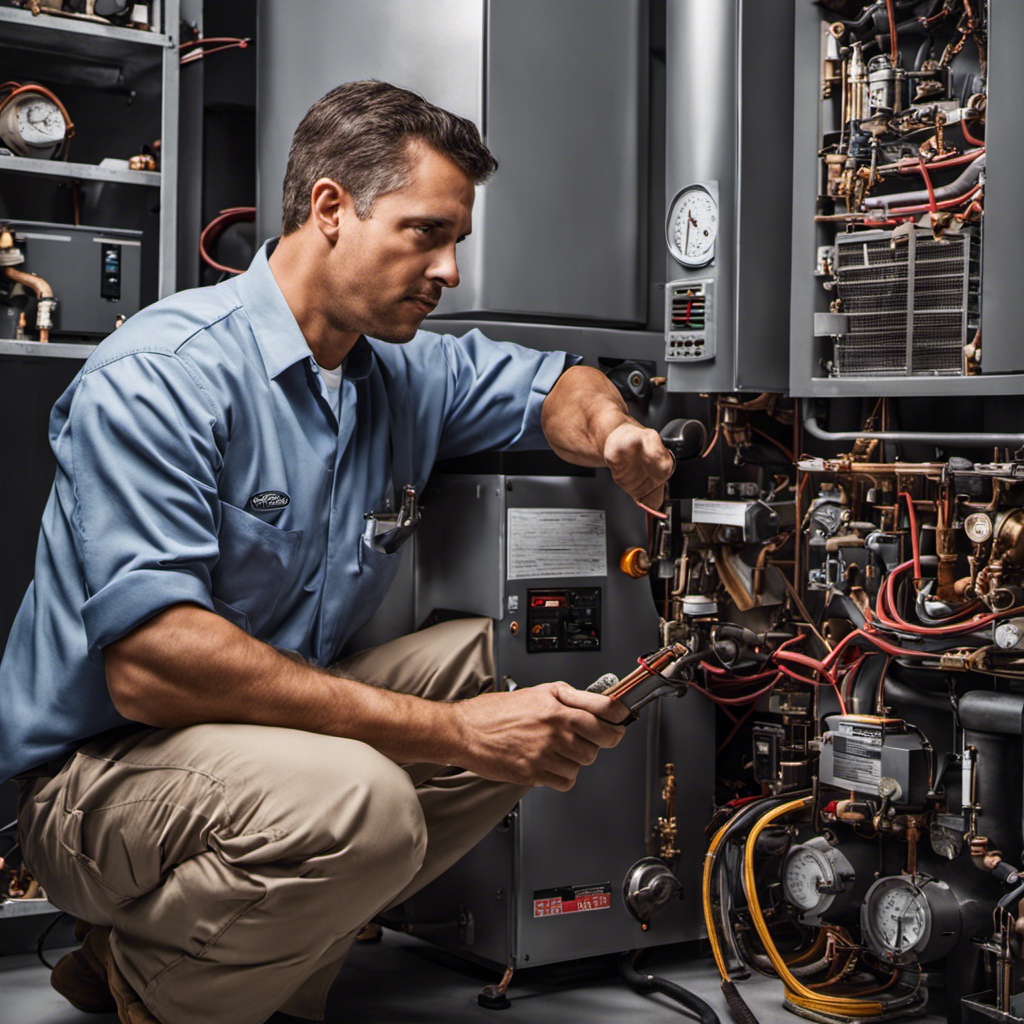Replacing a furnace can be a significant financial investment. This article delves into the reasons behind the high cost of furnace replacement.
From the expenses associated with materials and labor to the additional costs of upgrading to energy-efficient models and modifying ductwork, there are various factors that contribute to the overall expense.
Furthermore, permits, inspections, maintenance, and warranty expenses also add to the financial burden.
Understanding these factors can help homeowners make informed decisions when it comes to replacing their furnace.
Key Takeaways
- The cost of replacing a furnace is high due to the significant cost of materials and labor involved.
- Upgrading to energy-efficient models can lead to long-term savings and reduce monthly heating costs.
- Additional costs may arise from ductwork modifications to accommodate the new furnace’s ventilation requirements.
- Permits and inspections are necessary for safety and compliance with codes and regulations during the installation process.
The Cost of Furnace Materials
When considering the overall expenses of replacing a furnace, it is essential to take into account the significant cost of furnace materials. The cost of furnace parts can vary depending on the specific make and model of the furnace, as well as the complexity of the installation.
One factor that contributes to the cost is the manufacturer markups. Manufacturers often add a markup to the price of their furnace materials to cover their own expenses, such as research and development costs, marketing expenses, and overhead. This markup can significantly increase the cost of furnace materials for consumers.
However, it is important to remember that these markups are necessary for manufacturers to continue producing high-quality furnace materials and provide excellent customer service.
Labor and Installation Expenses
The cost of replacing a furnace is significantly influenced by the labor and installation expenses involved in the process. When it comes to installing a new furnace, the installation timeline plays a crucial role in determining the overall cost. Depending on the complexity of the installation, it may take several hours or even a couple of days to complete. This means that the labor costs can add up quickly.
Additionally, it is important to be aware of any hidden fees that may arise during the installation process. These hidden fees can include additional materials needed for installation, unforeseen repairs or modifications required, or even disposal fees for removing the old furnace. Being transparent about these potential costs upfront can help homeowners better understand and prepare for the total expenses involved in replacing their furnace.
Upgrading to Energy-Efficient Models
Why should homeowners consider upgrading to energy-efficient models when replacing their furnace?
Upgrading to energy-efficient models offers several benefits, including energy-saving features and long-term savings. Energy-efficient furnaces are designed to consume less energy while still providing the same level of warmth and comfort. These models often come equipped with advanced technologies, such as variable speed motors and programmable thermostats, which optimize energy usage and reduce utility bills.
By investing in an energy-efficient furnace, homeowners can save money on their monthly heating costs. Additionally, these models often have a longer lifespan and require fewer repairs, resulting in further savings in the long run.
Choosing an energy-efficient model not only benefits homeowners financially but also helps protect the environment by reducing energy consumption and greenhouse gas emissions.
Additional Costs for Ductwork Modifications
Although ductwork modifications may not always be necessary, they can sometimes incur additional costs when replacing a furnace.
Ductwork modifications refer to the changes made to the existing duct system to accommodate the new furnace’s ventilation requirements. These modifications can include resizing or rerouting the ducts, adding or removing vents, or sealing leaks and gaps.
The cost of ductwork modifications depends on the complexity of the changes needed and the size of the duct system. In some cases, the existing ductwork may not meet the ventilation requirements of the new furnace, requiring extensive modifications or even the installation of a completely new duct system.
It is essential to consult with a professional HVAC technician to determine if ductwork modifications are necessary and to get an accurate estimate of the associated costs.
Permits and Inspections
Additionally, before undertaking the replacement of a furnace, it is crucial to note that permits and inspections are regularly required by local authorities to ensure compliance with safety regulations and building codes.
These permits and inspections are necessary to protect the homeowner and ensure that the new furnace is installed properly and safely. Local regulations vary, but generally, a permit must be obtained before the installation process can begin. The permit ensures that the installation is done by a licensed professional who understands the local codes and regulations.
Inspections are then conducted at various stages of the installation to verify compliance with these codes. While these permits and inspections may add to the overall cost of replacing a furnace, they are essential for the safety and well-being of the homeowner and their property.
Maintenance and Warranty Expenses
To properly maintain a furnace and ensure the validity of the warranty, homeowners should be aware of the potential expenses associated with regular maintenance and warranty coverage.
Regular maintenance costs are an essential aspect of keeping a furnace in good working condition and maximizing its lifespan. It is recommended to schedule annual maintenance visits with a qualified technician to clean, inspect, and tune up the furnace. These visits typically involve a fee that covers the technician’s time and any necessary replacement parts.
Additionally, homeowners should consider the option of purchasing extended warranties for their furnaces. Extended warranties provide coverage beyond the standard warranty period and can help protect against unexpected repair costs. However, it’s important to carefully review the terms and conditions of the extended warranty to understand what is covered and any associated costs.
Frequently Asked Questions
Are There Any Financing Options Available for Replacing a Furnace?
Financing options are available for replacing a furnace, providing homeowners with the opportunity to spread the cost over time. These options can help alleviate the financial burden and make furnace replacement more accessible to those in need.
How Long Does the Process of Replacing a Furnace Typically Take?
The installation timeline for replacing a furnace typically depends on various factors such as the size of the unit and any additional modifications required. On average, the process can take anywhere from a few hours to a couple of days. The cost of furnace replacement varies based on factors such as the type of furnace, the complexity of the installation, and any necessary upgrades or modifications.
Can I Install a Furnace Myself to Save on Labor Costs?
Installing a furnace yourself, also known as DIY furnace installation, can potentially save on labor costs, but it is important to consider the complexity and potential risks involved. Professional installation ensures proper functioning and compliance with safety standards.
Are There Any Rebates or Incentives Available for Upgrading to an Energy-Efficient Furnace?
There are several rebate options and government incentives available for upgrading to an energy-efficient furnace. These incentives can help offset the cost of replacing a furnace and make it a more affordable investment in the long run.
What Factors Can Affect the Lifespan of a New Furnace?
Factors affecting furnace lifespan include regular maintenance, proper installation, and the quality of the furnace itself. Common signs of a failing furnace include frequent breakdowns, increased energy bills, and uneven heating.


